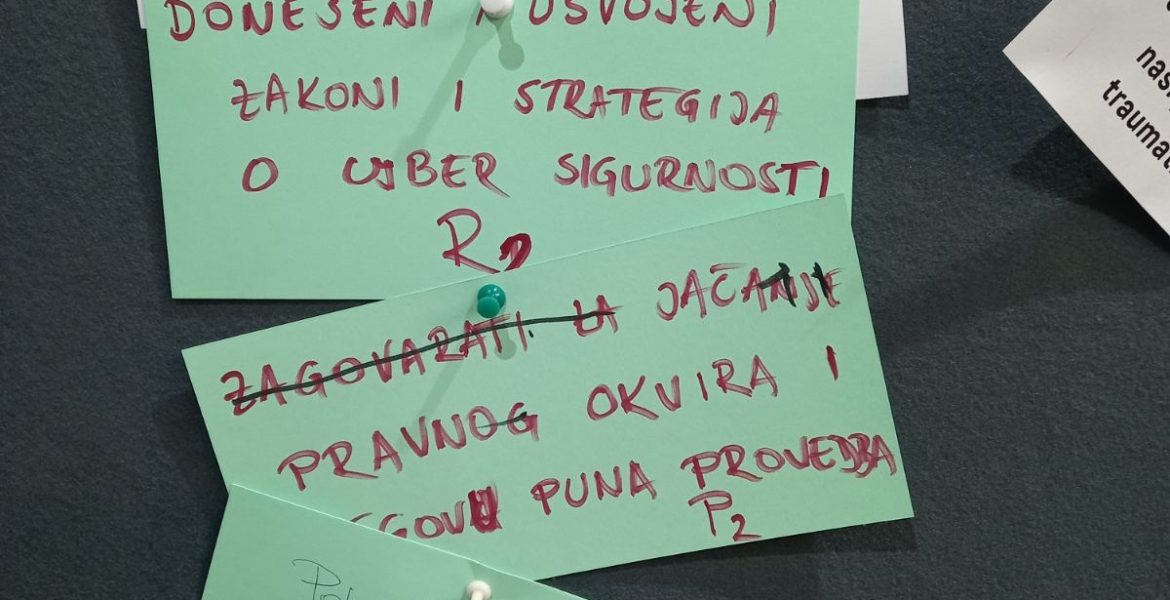The strategy towards young people of the Federation of Bosnia and Herzegovina strives to achieve a safe environment that strengthens the existential security of young people, reduces their vulnerability and exposure to risky behaviors, and improves opportunities and encourages the development of their full potential.
The strategy recognizes the importance of information, communication and mutual trust and cooperation of young people, parents and law enforcement agencies, as well as all civil society institutions and organizations that provide systemic support to people who have suffered some form of injury. In this strategy, young people are recognized as part of the solution, that is, active participants in raising awareness and creating preventive measures and actions in order to promote zero tolerance to violence, but also indispensable advisers on how to provide young people with safe and supportive ways to report crime, but also to achieve protection and recovery support.
Young people are also recognized in the context of security as a non-homogeneous population group with pronounced vulnerability, partly due to specific needs, partly due to their own capacities that are still developing, and partly due to an environment that is changing tremendously and whose demands are becoming greater. For these reasons, every young person needs stable systemic support that minimizes risks.
Young people in the Federation of Bosnia and Herzegovina perceive security from several different aspects, which include social, economic, health and security risks and not only as an immediate danger to life. This consideration of the environment, on the basis of which young people assess their chances for survival, development and prosperity, is called the concept of human security, and it provides insight into the connection between the satisfaction of a series of prerequisites that each person needs when assessing whether the environment is suitable, whether they will remain in that environment and what are the things that should be paid attention to in order to maintain personal integrity, peace and take advantage of opportunities for development.
It is a devastating fact that during the research on the position and needs of young people in FBIH conducted by the Institute for Youth Development KULT, as many as 44.4% of all surveyed young people declared that they were dissatisfied with the security situation in their environment.
Why is this so and what are the reasons why the youth of FBiH see their environment as a source of fear and insecurity?
Economic independence is the basis for independent decision-making and life planning, and the high unemployment rate among young people very often leads them to poverty, social exclusion, marginalization, and additional challenges such as discrimination and potentially at risk of exploitation. Squeezed between limited opportunities and growing needs, young people often find themselves forced to work in precarious conditions and without adequate rights and protection, conditioned to mere survival instead of growth and development. As part of the fight against human trafficking, more and more attention is being drawn to the problem of labor exploitation where the victims are primarily young people.
In addition to such threats and insecurities, other factors such as violence, criminality and deviant behaviors in society that expose young people to physical and psychological risks certainly have a strong influence on the perception of young people as to how safe they perceive their environment to be. The consequences of risks that were not paid attention to are read in black chronicles.
The Federal Bureau of Statistics, through the publication “Judiciary Statistics” for 2022, provides insight into the position of young people when it comes to the state of crime, where it is stated that young people and children make up 36.38% of victims of all criminal acts.
The most alarming fact is that this population group makes up 97.6% of all victims of crimes against sexual freedom and morality, that is, crimes of sexual violence and rape.
In criminal acts of domestic violence, 48.79% of the victims are children and young people aged 18 to 29. It is important to note that 78.13% of victims are girls and young women. Research on the position and needs of young people in FBIH conducted by the Institute reveals that 24.6% of the young people surveyed said that they knew a person who survived domestic violence, while 1.7% had the strength to declare that they themselves were victims of domestic violence. The number of offenders aged 18-29 is 19.48% of the total number of adult offenders
Children and young people aged 18 to 29 make up 35.48% of all victims of crimes against life and limb, which refer to murders and bodily injuries. At the same time, 33.20% of the perpetrators are between the ages of 18 and 29.
Children and young people aged 18 to 29 make up 47.78% of traffic fatalities. Young drivers, who make up over 36% of the perpetrators of this crime, are often involved in traffic accidents due to inexperience, driving under the influence of alcohol or drugs, and disobeying traffic regulations.
Even in the peer environment, young people are not spared from the threats of physical, verbal and cyber violence, which seriously endangers their safety and mental health. During the research on the position and needs of young people in the FBIH, 34.5% of the respondents stated that they knew a person who suffered peer violence, and 13% of the young people surveyed said that they themselves had been exposed to this violence.
Difficulties in finding help and getting out of an abusive environment often lead young people to abuse alcohol, narcotics and other psychoactive substances, which only deepens the problem and often leads to health problems, addiction and related criminal activities. According to the data of the FBiH Bureau of Statistics published in the publication “Judiciary Statistics” in 2022, 1,546 crimes against human health were reported to the FBIH, of the total number of reported perpetrators, 795 or 51.42% of the perpetrators belong to the youth population (16 persons under the age of 18 and 779 persons between the ages of 18 and 29), according to the classification in the field of criminal law, these criminal offenses include the unauthorized production and distribution of narcotic drugs, as well as the possession and facilitation of the consumption of narcotic drugs.
In terms of treating violence as a social problem, and especially taking into account the category of young people, it is very important to work with the victims, but also with the perpetrators of violence.
The FBIH youth strategy recognizes this need and sets as a priority measure the parallel development of a multidisciplinary violence prevention program in order to create a safe environment and promote a culture of non-violence and the establishment of a support system for young people who are exposed to risky behaviors or are victims of violence, in order to ensure that young people they have the resources needed to face challenges and overcome crisis situations.
Global trends in information, education and ways of spending free time have influenced the increased reliance of young people on technology. However, due to the expansion and abuse of technology and artificial intelligence, the vulnerability of young people has increased, that is, the risk of attacks on their privacy and security. The exposure of young people to misinformation, fake news and indoctrination seems to be the least problematic, but we must not forget that young people are informed through social networks, that there is no censorship on them, nor is there any control of the veracity of information, and that such content massively influences the formation of attitudes, behavior and decision making. Young people are sometimes the target of radical groups who try to recruit them into terrorist or extremist activities on social networks.
The youth population, although much more computer literate and capable than the rest of the population, often do not fully understand the importance of personal data protection, which can lead them to problems such as identity theft, fraud or account hacking. Online scams such as phishing or false offers and exploitation are on the rise, so young people are at risk of becoming victims of fraud, identity theft or even sexual exploitation. The causes of this problem can be seen in computer illiteracy, insufficient parental attention, insufficient knowledge of potential dangers
The cause-and-effect relationship between behavior and virtual acts with problems and their consequences in the real world is probably the most difficult thing to fix, so Cyberbullying in a large number of cases has serious consequences for the mental health of young people. The risk of being a victim of insults, threats, false rumors or embarrassment on social networks, forums and other online platforms is a daily occurrence for many young people, and on the other hand, the perpetrators go unpunished. Photo processing tools, the availability of personal photos of the young person on social networks and a wide audience from the young person’s environment, enable predators and abusers to market false pornographic content, violent video content and other materials that humiliate and embarrass the young person, and such materials are often used and for blackmail. The problem with abuse on the Internet, which is cited by law enforcement forces as well as the victims themselves, is the constant uncertainty of whether humiliating content that has been published and removed by the intervention of police experts will reappear at some point.
These threats, considering the lifestyle, represent a significant problem for young people, while at the same time there is a lack of quality formal and informal education in the field of youth safety that connects activities in the sphere of cyberspace with consequences in material space. In order to reduce these risks, it is important that young people are educated about safety on the Internet, that parents and guardians are involved and informed, but also that legal solutions offer adequate opportunities to prosecute and punish perpetrators.
In addition to the peer environment for young people, especially the youngest age group, family support and examples are of inestimable importance, and the strategy towards young people, in addition to raising awareness among young people about potential risks and ways of protection, also does not neglect activities in the field of working with parents. Recognizing risky behaviors is the best way to provide security to young people, and educated parents will face potential challenges more easily and better, as well as ensure early intervention in cases of potential problems.
The FBIH Youth Strategy recognizes the importance of promoting digital literacy and providing resources for education about cyber threats and prevention of online abuse that can help overcome these challenges. At the same time, the improvement of the legal framework and the implementation of laws in the area of youth safety on the Internet is set as a priority and direction of action. By providing a model for reporting cybercrime and a support system for victims/victims, young people would be enabled to report cybercrime and abuse of the Internet through safe channels. In this way, competent institutions would have better and more information necessary for a quick and efficient reaction
Addressing these risks and providing support for young people to feel safer requires coordinated efforts from different sectors, including education, health care, social services, and police and justice institutions. The youth strategy recognizes the necessity of such an approach and sets as a course of action the improvement of intersectoral cooperation with the development of a youth-friendly approach in all institutions that provide services to young people (health, social) and law enforcement and security agencies.
The bearer of the initiative to create a strategy for the youth of the Federation of Bosnia and Herzegovina is the Federal Ministry of Culture and Sports in partnership with the Institute for Youth Development KULT and the Youth Council of the Federation of Bosnia and Herzegovina.
Source: mladi.org





